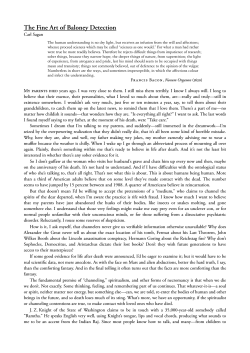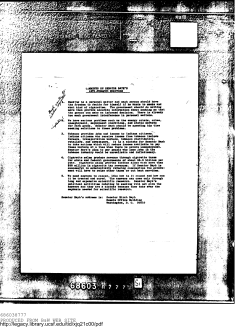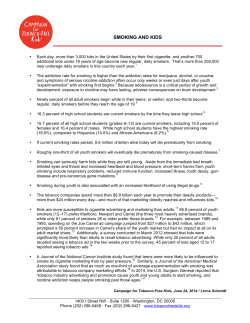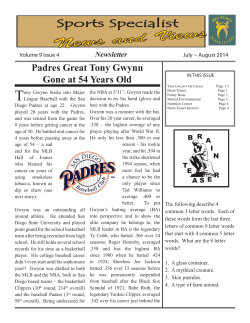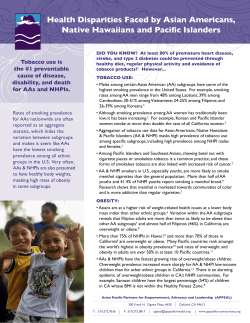
Additive-free Processed Cigarette Leaf (“PCL”): A potential new use for...
Additive-free Processed Cigarette Leaf (“PCL”): A potential new use for an old material J.H. Lauterbach (1), M.F. Forbes (1), D.A. Grimm (2) (1) Lauterbach & Associates, LLC, Macon, GA 31210-4708 USA. (2) Coordinated Instrumentation Facility, Tulane University, New Orleans, LA 70118-5698 USA Abstract Processed cigarette leaf (“PCL”) refers to several types of band-cast reconstituted tobaccos developed by Brown and Williamson Tobacco Corporation (“B&W”) and other British-American Tobacco (“BAT”) units during the 1950s and 1960s (http://legacy.library.ucsf.edu/tid/wsa51f00/pdf). In the B&W implementation of PCL, there were no chemical additives used in the PCL process except for addition of glycerin as a humectant. PCL was used until the late 1970s, when it was replaced by a papertype reconstituted tobacco that had much reduced costs associated with its use. However, the PCL process may offer advantages today if it could be used to produce a truly additive-free reconstituted tobacco. Consequently, we have produced PCL on a laboratory-scale using a recipe and process conditions from a 1967 B&W report (http://legacy.library.ucsf.edu/tid/hao00f00/pdf), and we have profiled the starting furnish and finished product with classical chemical analyses and two GC-MS techniques. Aqueous slurries of ground burley stem and ground flue-cured stem were cooked under pressure for about 30 minutes at 143ºC and 132ºC, respectively. The cooked slurries were mixed and processed in a high-speed blender. After additional dilution with water, mixed 50/50 flue-cured/burley lamina fines were added (lamina/stem 1.4/1), and the mixture was cooked for 4 h at about 90ºC with further water added to dilute the slurry to about 9% solids. The slurry was applied to drying sheets and dried at 100ºC until most of the water had evaporated. The dried tobacco films were equilibrated overnight at around 65% RH. They were flexible without addition of humectants, and gave off a pleasant aroma during smoulder. Chemical changes shown by the GC-MS analyses were those expected from treating tobacco with hot water. Original B&W Process Flow (from Reference 1) 800 lbs RFX stems 400 gallons water o 270 F for 30 minutes Disintegrate One pass through 0.050 round-hole screen Discussion Band-cast reconstituted tobaccos were popular before the widespread use of the more economical paper-type reconstituted tobaccos. The 1976 report by Molyneux describes four such band-cast products (known as PCL for processed cigarette leaf) that were manufactured and used by the British-American Tobacco companies during the 1960s and 1970s. The PCL manufactured by B&W is of particular contemporary interest because it is contained a mixed burley/flue-cured furnish and was additive-free except for the addition of 3% glycerin. The recipe variant chosen reportedly gave PCL with much better flex values than did the standard recipe. When the finished sheet is conditioned, it is flexible. Thickness is around 10 to 15 mils and is typical the values reported by Molyneux (2). He also reported that for B&W PCL, it was thought that lamina was more important to the final PCL physical properties than stem and that longer heating of the slurry before casting helped both the physical and smoke sensory properties of the PCL. During the final heating of the slurry before casting and during drying, there was a noticeable chocolate-like aroma to the mixture, that was typical of reactions that result in the formation of pyrazines. Volatile pyrazines are byproducts of the reactions of sugars with ammonia and its compounds. Markers of such reactions were found in the PCL through use of the DS Scan GC-MS technique (3) as shown in the GC-MS scan below. Adjust to 3500 gallons o and 140 F then Homogenize 3 passes @4000 psi 800 lbs RBX stems 400 gallons water o 290 F for 30 minutes Add 2274 lbs of mixed lamina o Store for 4 hours at 195 F Add 190 lbs of glycerin Adjust volume to 4900 gallons Disintegrate 2 passes Glycerin Final storage before casting Phosphate Objectives Adaptation of Process to Laboratory-Scale Production The main objective of this work was to produce an additive free-reconstituted tobacco that had acceptable sensory properties, that would also be a viable alternative to conventional reconstituted tobaccos in the event of a total ban on tobacco additives, and that would be suitable for use in an additive-free tobacco blend.. The second objective of this research was to understand that chemistry of processed cigarette leaf (“PCL”) process as practiced at Brown & Williamson Tobacco Corporation (“B&W”). The primary difficulty in adapting the recipe (1) to laboratory-scale production was finding an acceptable autoclave. We contracted with the Institute of Paper Science at Georgia Institute of Technology to autoclave the stem samples. The size of the equipment limited each cook to a total volume of ~750 mL. The weights of the tobacco furnish and the volumes of water were scaled-down to match the limitations of the autoclave. The scaleddown recipe called for 85 g of small burley stem (RBX) and 145 g of small flue-cured stem (RFX). The second difficulty was the lack of disintegrators and homogenizers to reduce the particle size of the stem and lamina after cooking. We overcame this difficulty through reducing the particle size of the starting tobacco fractions to – 10 mesh and through extensive use of the NINJA blender to further reduce the particle size of the slurries. The third difficulty was duplicating the casting and drying of the slurry on continuous band. We found that the best method for casting the slurry was to apply pressure sensitive tape (~ 0.1 in thick) to the edges of a cookie sheet, pour about 250 mL of freshly blended slurry along one edge of the cookie sheet and the use a doctor blade to draw down an even layer of the slurry. A forced draft oven at 175ºF was used to dry the cast slurry. Materials and Methods The recipe and procedure for preparation of the PCL samples was taken from a 1967 B&W report (1). All tobaccos came from commercial sources. The stem side (small burley stem, small flue-cured stem) was per recipe (1). The by-products (e.g., winnowers, fines) used in the recipe were replaced by a 50/50 mixture of burley and flue-cured lamina. Tobaccos were ground to pass a 10-mesh screen before use. An integral part of the PCL process is the pressure-cooking of the stem. Burley stem was pressure-cooked at ~290ºF (~58 psig) and flue-cured stem was pressure-cooked at ~270ºF (~27 psig). Cook times were 30 minutes after stable temperatures were reached. The same ratio of water/stem was used as in the recipe (1). After cooking, each stem fraction was diluted with water and thoroughly blended in a NINJA NJ600 Professional Blender (Euro-Pro Operating LLC in Newton, MA). The lamina fractions were mixed with water and thoroughly blended in the NINJA. The stem and lamina fractions were mixed together in an 8-quart double boiler and heated with occasional stirring for at least 6 hours at about 195ºF. Unlike the recipe (1), no glycerin was added. The slurry was diluted with water to ~ 8% solids, blended again in the NINJA, cast on cookie sheets with drying at ~175ºF. After conditioning, the samples were sent to a laboratory for routine chemical analysis. Results are shown in the table below. Alkaloids Total Sugar Reducing Sugar Sample PCL DAY 1 2.07 9.23 9.73 PCL DAY 2 2.13 8.37 9.33 Mean (as is basis) 2.10 8.80 9.53 Moisture correction 0.903 0.903 0.903 Mean (dry weight basis) 2.33 9.75 10.56 Nitrate 2.20 2.29 2.25 0.903 2.49 Chloride 1.47 1.52 1.50 0.903 1.66 Moisture 10.23 9.20 9.72 Trace of sucrose Conclusions The main objective of this work was to produce an additive free-reconstituted tobacco that had acceptable sensory properties, that would also be a viable alternative to conventional reconstituted tobaccos in the event of a total ban on tobacco additives, and that would be suitable for use in an additive-free tobacco blend.. The second objective of this research was to understand that chemistry of processed cigarette leaf (“PCL”) process as practiced at Brown & Williamson Tobacco Corporation (“B&W”). References 1. Strubel, D.G., McTeague, G.D. 1967. Special PCL Samples. Brown & Williamson Tobacco Corporation report. March 3, 1967. Available at http://legacy. library.ucsf.edu/tid/hao00f00/pdf (August 26, 2012). 2. Molyneux, D.J. 1976. Survey of PCL-type tobacco reconstitution processes in the BA.T Group. B-A.T Report No . RD .1331. February 18, 1967. Available at http://legacy.library.ucsf.edu/tid/wsa51f00/pdf (August 26, 2012). 3. Lauterbach, J. H., Grimm, D.A., 2010. Use of two GC-MS scan techniques for the characterization of tobacco fillers used in cigar products. CORESTA Congress Edinburgh, Smoke Science/Product Technology Groups SSPT16.
© Copyright 2025


